Vertaling en analyse van woorden door kunstmatige intelligentie ChatGPT
Op deze pagina kunt u een gedetailleerde analyse krijgen van een woord of zin, geproduceerd met behulp van de beste kunstmatige intelligentietechnologie tot nu toe:
- hoe het woord wordt gebruikt
- gebruiksfrequentie
- het wordt vaker gebruikt in mondelinge of schriftelijke toespraken
- opties voor woordvertaling
- Gebruiksvoorbeelden (meerdere zinnen met vertaling)
- etymologie
CB Citizens Band - vertaling naar Engels
[sitiz(ə)nz'bænd]
общая лексика
любительский радиодиапазон
Definitie

Wikipedia

Citizens band radio (also known as CB radio), used in many countries, is a land mobile radio system, a system allowing short-distance one-to-many bidirectional voice communication among individuals, using two-way radios operating on 40 channels near 27 MHz (11 m) in the high frequency (a.k.a. shortwave) band. Citizens band is distinct from other personal radio service allocations such as FRS, GMRS, MURS, UHF CB and the Amateur Radio Service ("ham" radio). In many countries, CB operation does not require a license, and (unlike amateur radio) it may be used for business or personal communications. Like many other land mobile radio services, multiple radios in a local area share a single frequency channel, but only one can transmit at a time. The radio is normally in receive mode to receive transmissions of other radios on the channel; when users want to talk they press a "push to talk" button on their radio, which turns on their transmitter. Users on a channel must take turns talking. Transmitter power is limited to 4 watts in the US and the EU. CB radios have a range of about 3 miles (4.8 km) to 20 miles (32 km) depending on terrain, for line of sight communication; however, various radio propagation conditions may intermittently allow communication over much greater distances.
Multiple countries have created similar radio services, with varying technical standards and requirements for licensing. While they may be known by other names, such as the General Radio Service in Canada, they often use similar frequencies (26–28 MHz) and have similar uses, and similar technical standards. Although licenses may be required, eligibility is generally simple. Some countries also have personal radio services in the UHF band, such as the European PMR446 and the Australian UHF CB.


 radio.jpg?width=200)




